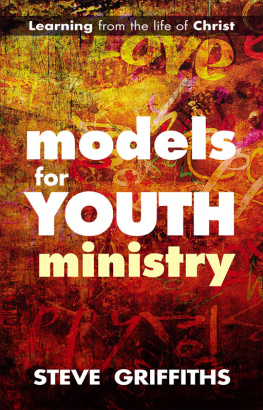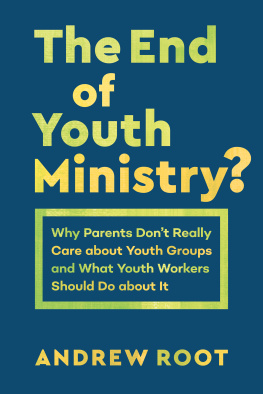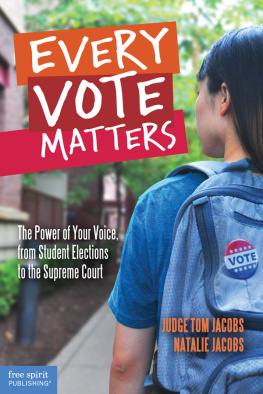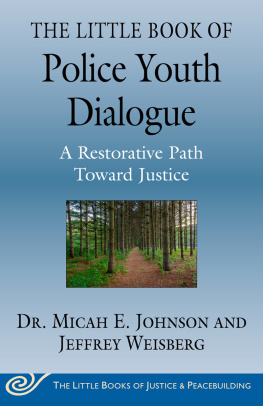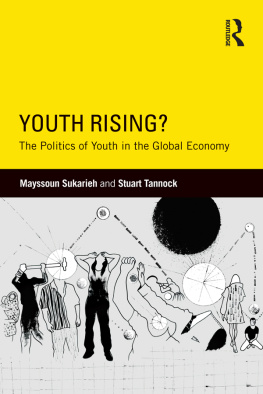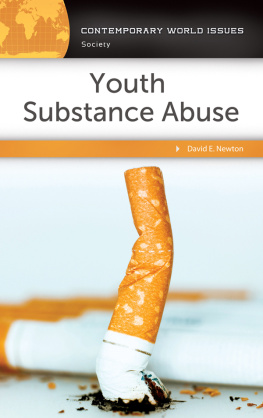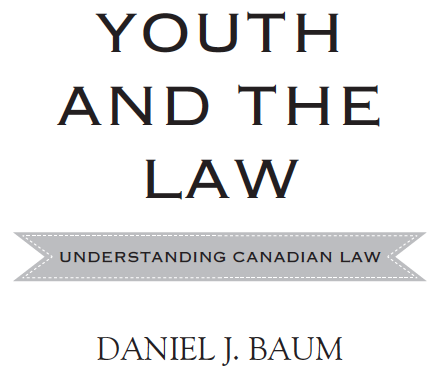Copyright
Copyright Daniel J. Baum, 2014
All rights reserved. No part of this publication may be reproduced, stored in a retrieval system, or transmitted in any form or by any means, electronic, mechanical, photocopying, recording, or otherwise (except for brief passages for purposes of review) without the prior permission of Dundurn Press. Permission to photocopy should be requested from Access Copyright.
Editors: Katie Scott and Michael Melgaard
Design: Jesse Hooper
Epub Design: Carmen Giraudy
L ibrary and Archives Canada Cataloguing in Publication
Baum, Daniel Jay, 1934-, author
Youth and the law / Daniel J. Baum.
(Understanding Canadian law ; number 1)
Includes index.
Issued in print and electronic formats.
ISBN 978-1-4597-1955-2 (pbk.).--ISBN 978-1-4597-1956-9 (pdf).--ISBN 978-1-4597-1957-6 (epub)
1. Juvenile justice, Administration of--Canada. 2. Youth--Legal status, laws, etc.--Canada. I. Title.
KE9445.B39 2014 345.7103 C2013-907407-4
KF9780.ZA2B39 2014 C2013-907408-2
We acknowledge the support of the Canada Council for the Arts and the Ontario Arts Council for our publishing program. We also acknowledge the financial support of the Government of Canada through the Canada Book Fund and Livres Canada Books, and the Government of Ontario through the Ontario Book Publishing Tax Credit and the Ontario Media Development Corporation.
Care has been taken to trace the ownership of copyright material used in this book. The author and the publisher welcome any information enabling them to rectify any references or credits in subsequent editions.
J. Kirk Howard, President
The publisher is not responsible for websites or their content unless they are owned by the publisher.
Visit us at: Dundurn.com
Pinterest.com/dundurnpress
@dundurnpress
Facebook.com/dundurnpress
Acknowledgements
F irst , I would like to acknowledge the Supreme Court of Canada. Over the decades, the membership of this nine-person Court has altered through retirement (mandatory at age seventy-five) or death. Increasingly, the Court has tried to hand down judgments that come ever closer to being decisions that can be read, understood, and discussed by those who want to be informed about the structure of our law, of our government, and more importantly, of our societys values. So, I thank most profusely the Supreme Court of Canada.
A second link in the chain between the law and the people is the media. It is possible, of course, in our highly computerized society to read the decisions of the Supreme Court of Canada online, but that can be an arduous process. On occasion, magazines such as Macleans feature a particular subject for investigative reporting, in which the Supreme Court of Canadas judgments (such as those relating to tobacco) may form a part. Newspapers such as the Toronto Star may select a story reflecting a matter of social concern, such as bullying. And, on a daily basis, radio or television may briefly report on such stories.
The net effect of media reporting, at best, ranges from episodic to minimal. Perhaps the one constant to which we frequently refer in this series is the informed editorials in Canadas national newspaper, the Globe and Mail . Without hesitating, the Globe and Mail granted the right to reprint editorials (and there were many) on Supreme Court of Canada decisions. The approach of the Globe and Mail seems to be: Let the public be made aware. I thank them for their generosity and for maintaining consistently high standards.
Ordinarily, I would say that I take full responsibility for the contents of this book. Hopefully, however, the contents do not reflect my judgments but those of the Supreme Court of Canada. My task, as I saw it, was to discuss those judgments in a nonjudgmental and accessible way.
Introduction
I ts the law! What does that mean? If the law is broken, especially the criminal law, then there may be a penalty, such as a fine or jail time, or community service, or conditional release. But who makes the law? Is it the government? How can a legislature draw clear lines, for example, in imposing individual responsibility?
Consider a fifteen-year-old victim of school bullying. He has had enough. He takes his fathers gun from a locked closet, loads it, and goes to school, where he shoots and seriously wounds one of his bullies. He is apprehended and charged. But how is he to be tried and, if found guilty, sentenced? Is he to be treated as a young offender or as an adult? If convicted, will he have a record that will follow him through high school and university, and into the job market? Is it really enough to say that a court will make the decisions?
The central issue explored in Youth and the Law is how a court makes such decisions. We will find that, like most laws intended to carry forward important public policy, those relating to young offenders significantly depend upon the courts to give such policy meaning in specific applications. Public policy has not varied for decades: protect and guide the young and, at the same time, protect society. How is a court to interpret this policy in legal decisions? After all, isnt the only real meaning of the law how it is applied in specific cases?
The several thousand courts in Canada operate under certain principles or guidelines. A primary source of those principles is the Supreme Court of Canada. That is our jumping-off point: specific cases decided by that final arbiter, the Supreme Court of Canada. It may take five or more years for the Supreme Court to hear and decide an appeal. Yet, once the Supreme Court decides the case, it becomes the law. The majority decision of the nine justices of the Supreme Court is binding not only on the parties to the case, but on all people living in this country. The Courts ruling is the law of the land. It binds lower courts, legislatures, citizens, and residents of Canada. Only with considerable difficulty can a legislature overturn a Supreme Court ruling.
The Court generally does not make law; rather, it interprets the law in a specific case. In doing so, the lower courts findings are reviewed, and the Court then applies those findings to its own interpretation of the law. The parties to a case get an answer to their conflict: yes, no, or maybe. Sometimes the case is returned to the lower court for further proceedings on issues outlined but not resolved by the Court. For the most part, the parties are not interested in much else other than an answer.
The decision that is binding on the nation is how the Court explains itself how it defines the issues and its reasoning in bringing them to conclusion. In this book, every effort has been made to present the Courts reasoning objectively and clearly. Readers will be given citations to access the Courts decisions online and will be left to critique judgments.



